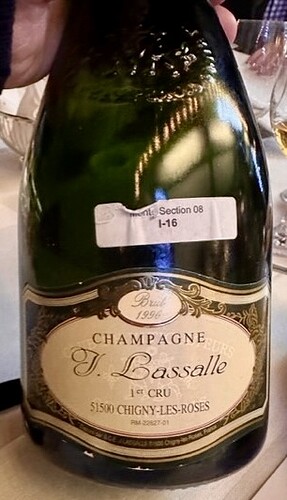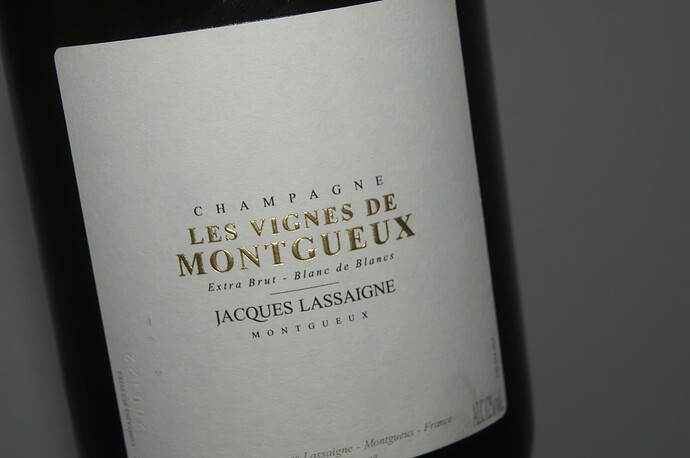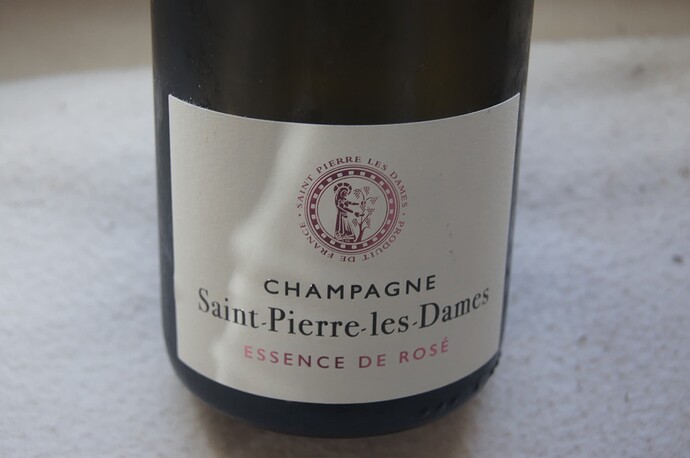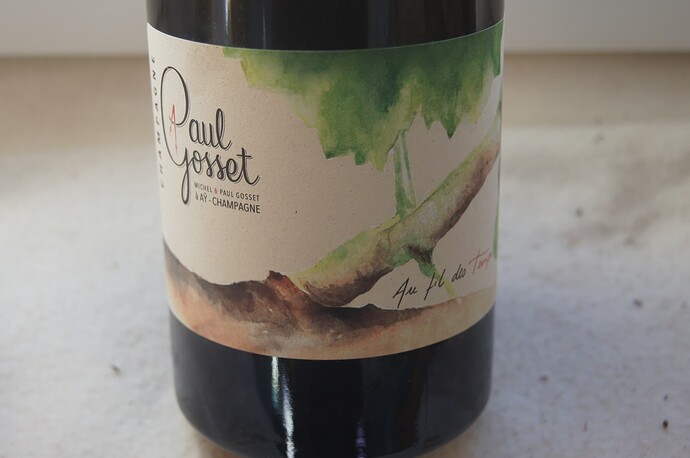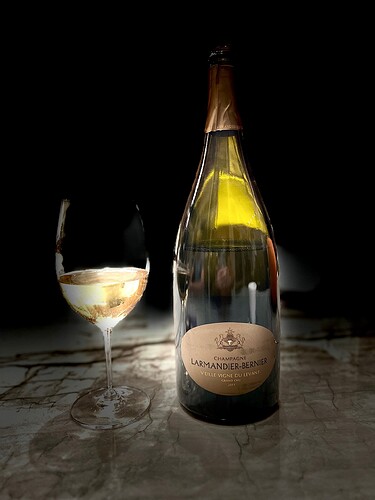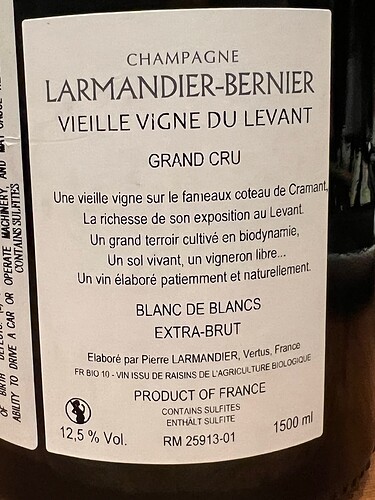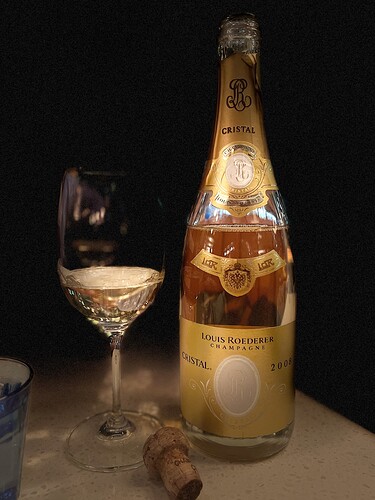It’s better that way
Just a few notes from some recent bottles. I found the 18 base L-B Longitude to be in an odd place, although it might be the sun of the vintage making the wine express itself in the way I tasted it. I really dug the 2010 L-B Levant, as it has an elegance and complete expression that is beautiful. I do believe, and this is my own palate talking, that the wine is ready to go. It’s the 3rd bottle I have had of it since release and they’ve all tasted complete, ready in that way. Thanks for reading.
-
2010 Larmandier-Bernier Champagne Grand Cru Vieille Vigne du Levant Extra Brut - France, Champagne, Champagne Grand Cru (11/13/2022)
From the June 2019 disgorgement. 100% Chard from old vines in Cramant. Tasted over 2 days. For Day 1, this has a toasty, citrus peel nose. The palate shows zesty green apple, lemon oil. With air, the energy improves and the flavors evolve to add yellow apple and peach. On Day 2, my overall impression of the wine is delicious. The yellow apple is present, along with an orange flesh and anise. Juicy, with a creamy, minty finish, in what is really just an elegant frame and a wine I think is right in the zone now. Really good and dialed in for joy now, not for aging, as the gentle quality of the wine doesn't portend a long life in my view. -
NV Champagne Suenen Champagne Grand Cru Oiry Blanc de Blancs Extra Brut - France, Champagne, Champagne Grand Cru (11/13/2022)
January 2021 disgorgement. 3 grams of dosage from 2017 base wine, 100% Chard. Green apple, honeyed peach, juicy pear and a light touch of lemon that provides enough acidity to lift the wine. -
NV Larmandier-Bernier Longitude - France, Champagne, Champagne Premier Cru (11/13/2022)
Another bottle of the 2018 base, which I got from the bottle etch code...but forgot to write down the disgorge date. When first opened, this reflected an approachable quality, a richer beam of lime, spiciness but overall missing a gear of energy. I retasted this the following day with a fresh palate, which helped me judge my Day 1 impression more accurately. Lavender and a creamy kind of feel, which is akin to the approachable quality from Day 1. The creamy impression reminds of lemongrass, meets mango, meets mint, and it borders on cloying. I like this bottle but don't love the cloying piece, but I suspect some people will dig it. I just prefer more acid and energy, which I know is going to be better built into the upcoming 2019 base wine when it finally arrives here in the US. -
2012 Bérêche et Fils Champagne Premier Cru Le Cran Ludes - France, Champagne, Champagne Premier Cru (11/11/2022)
Second bottle from the trio I bought. This bottle showed better than the first, and based on some of the feedback I overheard last night. others received the wine well, too. This is the July 2019 disgorgement, 50/50 Pinot Noir/Chard with 3 grams of dosage. The aromatics on this reminded me a lot of the 2008 Taittinger Comtes that was served alongside this Le Cran. A good whiff of honeysuckle and a bathroom talc/floral nose....really cool to smell. Tis has a good coil of lemon and lime citrus, paired with a slate mineral texture. The fruit spans the range from banana, peach, dried lime and terrific balance. I believe this cuvee has now passed through the $100 US, even $125 depending on where you find it, but I still really enjoy it and will stay with it provided the price stays in that range for what is in the bottle. -
2015 Chartogne-Taillet Champagne Hors Serie - France, Champagne (11/11/2022)
First time tasting this C-T cuvee. Not sure if this is the tete de cuvee but at a price into the $150 (or more) US, it's expensive. This wine took a little time to get my attention, and it needed some air to come around but when it did I really dug it. October 2020 disgorgement, 100% Chard farmed from Merfy and Avize. Ginger, pear with a good level of concentration. As the wine breathed out, I picked up mango and peach, which really rounded out the profile nicely. There is good structure here too. Appreciate Steve sharing this with us.
Posted from CellarTracker
A. Margaine Rosé de Saignée 2012
Disgorged Nov 2019. 75% PN and 25% Chard. 48 months on lees. Dosage 4-5g/L.
Color similar to sockeye salmon, perhaps a bit redder. Vivid small bead. Strawberry on the nose. Fresh strawberry, cranberry, and maybe some seville orange (?) on the palate. Very enjoyable, nice price point, and on my list to repurchase.
Yesterday, William Kelly posted a reply on another thread about what contributes to the various “oxidative” notes in “older” champagnes. It was quite the eye opener for me and filled in many blanks. Perhaps many of you already know this, but in case not, here’s the link:
Cheers,
Blake
Extracted from a thread just posted: and relative to the post above:
1996 J. LASSALLE BRUT CHIGNY-les-ROSES 1er Cru- served blind; the gold color suggested we had an elderly statesman and the nose confirmed it with advanced notes of honeyed caramel and butterscotch, although a nice touch of lemon lessened the oxidative influence; the taste profile was a very pleasant honey and nutty mature lemon apple which continued on through the finish; this bottle has reached or passed its apogee IMHO. Very enjoyable. It was an easy guess as to this having some age; I guessed `96, but knowing the one who brought it, I had it as a Dom or a Taittinger or a Dom Ruinart.
Thanks to William Kelly, I’ve learned “champagnes richer in Pinot will tend to get a bit more honeyed as they age, and those vinified in wood and/or blended with appreciable percentages of reserve wines will start out of the gates with a bit more nutty complexity, but the aromas of caramel and butterscotch are predominately related to the addition of sugar at disgorgement.
Interestingly, from a technical perspective, many of the aromas that are perceived as “oxidative” in older Champagnes are actually the result of Maillard-like reactions between residual sugars (including dosage) and amino acids liberated by yeast autolysis.”
Cheers,
Blake
Haha, it’s a good thing I happened to serve those as aperitifs! ![]()
To be fair, I think the Emotion is a big step up from the Rubis.
These are notes from a tasting we held a few weeks ago.
Antoine Chevalier Carkonnia 100% Chardonnay
To kick off the tasting and also to demonstrate a champagne that for me delivers at the 50€ mark. Nicely balanced, nice acidity, form a producer to watch out for from Vitry.
Pascal Doquet Mesnil Oger 2009
I have to admit, I expected more from this champagne. The wood although not dominating, set the tone. The structure is there and the acidity, not at the level of 2008, was quite nice. I think this needs times but the wood will decide the direction of the aromatics.
Vouette et Sorbée Blanc d’Argile
60% Chardonnay, 35% Pinot Blanc and 5% Arbane. 2018
A beautiful fresh linear champagne, the pronounced acidity and mineral are fantastic and the driving force in this champagne. Very young but massive potential.
Marie Courtin Blanc de Blancs 2018
An amphore champagne, also a blend of chardonnay and arbane. After the Vouette, this champagne did not really deliver, it has lost the initial freshness and for me is a champagne that is just going through the motions. The price is definitely not justified.
Lancelot Epernay 2017
The first natural champagne in the tasting. 100% Chardonnay. A real over deliver. The nose, the aromatics,the mineral drive and the finish made this the best champagne of the tasting so far. I tasted this in the summer and for me it was our discovery of the year. This tasting confirmed that impression.
Agrapart Avizoise 2015
In principle a big champagne that copes well with warm vintages, however after the Lancelot, although open, it just seemed to lack energy. Not a disappointment but just not exciting.
Champagne Avize Grand Cru Champ Cain Brut 2009 Jacquesson
The 2009 Champ Cain is clearly in substance a massive step above the other champagnes. Oxidative in nature, the champagne is open but still very young, the acidiy is really good and in terms of drinking windows, I believe this is one for the long haul.
Leclapart L’Aphrodisiaque 2017
My second bottle this year. The champagne is starting to put on wieght. With 20 % Pinot Noir and 80% Chardonnay, the Pinot Noir adds depth and the chardonnay the mineral drive and the acidity. This is the equal of the Jacquesson Champ Cain, just totally different. Anyone who ridicules natural wine is strongly advised to try this.
Champagner Drappier 2010 Grande Sendrée
After what I thought were going to be the big champagnes, I put in the Drappier to change the direction. At the price it delivered and improved with air. Still very young with lots of potential for the future.
Pouillon Chemin du Bois 2015
It is no longer possible for us to obtain Ulysse Collin, so this champagne was the best one I have in this ilk. For me too much toast aromas, Good acidity and nice substance, however no natural aromas, every thing is coming from the toasting. Has the champagne the muscles to emulate the wood, I don’t think so.
Jacquesson Degorgement Tardif 2012.
Is 2012 a big vintage, going from this champagne, yes. No traces of the warmer vintage, fresh, balanced a bit embryonic but the potential is there. I think with ten years this is going to be fantastic.
Egly-Ouriet Blanc de Noir
The last of the affordable Egly blanc de Noirs, the 2021 degorgement. Different to the Jacuesson but at the same level. The ambonnay bonus is there, more power and red fruit, impeccable balance with really good supporting minerality and acidity.
Charles Heidsieck Millésime 2012
My feeling was that the Millésime 2012 from Heidsieck was the equal of the Egly. I decanted this champagne and served blind. Firstly it was the equal of the Blanc de Noirs, more layered and multidimensional. Still a baby, but at 80 € a killer champagne and gives a reality check to the price inflation.
Roederer Cristal 2014
The biggest disappointment of the evening. The Crystal style is evident, just this champagnes lackes the verve and energy of the last and better vintages. 2014 is definitely a non-vintage and for me this champagne should never have been released. The one champagne where 11 drinkers were unanimous in judgement. Flop of the evening.
There were some rests inthe bottle, the only one I rasted was the Epernay from Lancelot which was now really singing.
The idea behind the tasting was to show diversity. The discussion was really robust, frank and enjoyable with quite in some case quite contrarian opinions.
In terms of price (under 60€) the Philippe Lancelot Les Hautes d’Epernay Millesime 2017 was for me the absolute winner. I know all the prejudices against natural wine, they may be justified when drinking the worst examples but when they are on, the energy, complexity and vivacity is something beautiful to behold. If one is obsessed with finding flaws, better not drink these for it is the flaws which make them so individual.
In terms of price, I think the general concensus was the majority of the champagnes are too expensive in terms of what they deliver. Cristal was really taking the piss. Also Egly, no question really good but I struggle to really enjoy these champagnes when the price goes over 200€. It will be interesting to see what happens with Jacquesson, I fear the worst.
Also stylistically we are not talking about big differences, I know a lot of drinkers are infatuated with the likes of Prevost, Bouchard or Ulysse Collin, I think the differences in quality are minimal, and there are plenty of alternative if one is not a point or label drinker.
Jacques Lassaigne Les Vignes de Montgueux Extra Brut Degorgemnet 20.01.2022
Popped and poured which was a mistake, at first one had to find the champagne within the champagne. A delicate, linear styled champagne with fresh tropical fruit aromas. Needs a lot of time to open up, really nice lime tasting acidity and oyster like salinity. Not powerfull more refined and filigree but with good persistence on the back palate.
Paul Gosset Au fil des Temps L’Été Année de Base 2018 (80%)
100% Pinot Noir 2g/l Degorgemtn 5 November 2021
The second set of champagne released from Paul Gosset. Last year Benoit Lahaye recommended us Gosset as an up and coming talent with really good holdings in Ay, Chouilly and Mareuil sur Ay. Interestingly Gosset told us, he wanted to producer champagnes in the style of Bollinger. His first release were not so impressive, they lacked concentration and substance, thsi we felt was due to such a short holding on the lees and releasing to soon after degorgement. The new releases 4 in all with the titles Hiver, printemps, l’éte and automne.
The l’éte is quite light and clear on the colour, unsual for a Pinot Noir, the nose is floral with a dominant pear note. On the first day a surprisingly light style of champagne from Ay, really fresh with medium acidity and subtle mineral pronounciation. On the second day the champagne has put on more body, the Ay substance comes through, also the oxidative element is more pronounced, the champagne is a bit lacking in persistence on the back palate but a definite step up from the first releases.
Saint-Pierre-Les-Dames Essence de Rosé. The second release of this champagne a blend of Chardonnay, Pinot Noir and Meunier and aged red Pinot Noir. No dosage or degorgement information are given. Delphine Laborde Coustheur was one of Matthieu Kauffmans pupils at Bollinger and was highly influenced by him. Whilst she worked at Bollinger, she was not allowed to producer her own champagne. This is now the second release of the Essence which is a massive step up to the first release, which now feels clumsy in comparison when one tries the second release. A nice pink salmon colour, nose is dominated by agrumes and violets. the perlage is subtler than the first release. The champagne is elegant, the acidity focussed and really nice saline minerality. The signature grapefruit/campari aroma is present but much more refined. The champagne has the Bollinger oxaditive note, really well integrated and much more subtle than Gosset. This is not one of those rosés, a white champagne with a drop of red wine to colour it but rather a beautifully blended champagne. I drunk this with cold roastbeef with horseradish cream, a combination made in heaven.
Earlier this year I was at a tasting with Emanuel Brochet, Delphine Laborde Coustheur was also present. The tasting became a discussion between both of them at a level that went over most of the participants heads. She has stated, she wants to become the Jacques Lassaigne of Nogent L’abesse, I think she is going to succeed. For me the best rosé champagne of the year.
Donald, does Jacques Lassaigne offer an NV entry level bottle? If so do you know what it’s called?
Les Vignes de Montgueux
This is the entry level wine.
Les Vignes de Montgueux is always the last two vintages and reserve wines,
Two wines from last week:
2011 Larmandier-Bernier VV du Levant out of a magnum. Don’t write off the '11 vintage. This wine has everything I could want in a BdB. Beautiful creamy white orchard fruit, citrus, almond paste in a warm croissant. I’m happy to have more 750’s and magnums, and even happier to have more of the 2012’s. It drinks phenomenally out of this format.
2008 Cristal. Stunning, but still tightly coiled. A multifarious nose and palate, from the typical young Cristal lemony prominence, to orange blossom and orchard fruit. Great cut and minerality, but… it’s still way too young, and I won’t be opening many of mine for a while. 2002’s are in a very good place, and the 2009’s are still precociously exceptional. While the 2008’s are tantalizing, they haven’t reach the level I expect them to down the road.
Cheers,
Warren
We had a bunch of stuff open yesterday and I didn’t get everything noted but we did knock through a lot of the Marie Courtin range. So, figured I would post there. Hey Warren, glad you like that 2011. I do too.
-
2015 Marie Courtin Champagne Efflorescence Extra Brut - France, Champagne (11/21/2022)
Opened yesterday. Just an ounce left for today's note. June 2021 disgorgement, 100% Pinot Noir done in old wood. No dosage, farmed bio. This bottle is consistent with the previous ones, both in texture and fruit. For texture, there is a glossy feel to the wine, what I almost could call oily but that would convey the wrong perception. Think of the wine as glossy, round, with a polish ti all of it. For the fruit, really hard to call this wine, as there are aspects that might fool me for Chard, such as the glossy apple and even what seems like a licorice note. Then, a mix of what seems like a pineapple (meaning the citrus) along with a red fruit, like a raspberry. This bottle has a unique edge to it and yet I don't see any reason why you can't enjoy it now. This is my final 15 Eff, gonna start looking for the 16. -
2016 Marie Courtin Champagne Concordance Extra Brut - France, Champagne (11/21/2022)
My final bottle of the 16. And, different from the past few I have opened, this is the September 2020 disgorgement. And like with the June 2021 disgorgement, there is some gold color here. But, where the similarity disappears is the wine's structure. This bottle, perhaps this disgorgement, has a distinct structure and backbone that is very present. Golden apple, even an edge of honey to it, but then a stone fruited like peach and cherry is thrust into the wine with the spine from the minerality. Man, the backbone in this bottle is notable, and it's been open for 24 hours under stopper. Finishes with some tangy lime citrus and saline. This is the bottle flair that wowed me back in June, this kind of quality. However, the source for those is long gone and I am just not excited about sourcing more from the later disgorgement and the advanced nature of that wine (at least to me and what I have found). Of note, this cuvee is sans soufre and so in 2016, in terms of my view into this, there is some bottle variation. I just wish they all tasted like this final bottle that is now gone! -
2017 Marie Courtin Champagne Presence - France, Champagne (11/21/2022)
Opened yesterday, just a few ounces left today to make this note. September 2019 disgorgement, the 70/30 blend of Chard/Pinot Blanc. This is distinctly juicy, with a lemon oil note, anise and some melon from what I would assume is the Pinot Blanc. As the wine finishes, the green apple, pear and anise carry the finish. There is a juicy, spicyness to this vintage of Presence, with both giving a solid length to the wine's finish. Good energy here, plenty to carry the wine for those who want to age it, just keep in mind this is sans soufre so if you have concern about the missing sulfur, then perhaps open the wines sooner, enjoy the juicy quality to what is here. -
2016 Marie Courtin Champagne Eloquence Blanc de Blancs Extra Brut - France, Champagne (11/20/2022)
July 2020 disgorgement of 100% Chardonnay, farmed bio without dosage,. Pulled this on a whim tonight. Gotta say, this bottle showed some polish and generosity that I had not found in the previous bottles. One comment I heard around the table was 'honey', and I can't recall saying that about this wine before. And for me, my sense of the wine was orange marmalade, which again is not what I attribute to Eloquence. I really enjoyed this bottle, and the expression it showed revealed something I wasn't expecting, which is very cool....retasting again the following day, I kept the wine under stopper. Today I get much more of the acidity, lots of lemony energy wrapping around a saline texture. When I let some warmth enter the wine, the apple comes through, but I don't get the marmalade today. But, I do get some apricot/stone fruit, even a little orange flesh. I did a few tastes of this tonight and man this has the energy and spine, which is why I have consistently been such a fan of Dominique's Chardonnay. This is really good.
Posted from CellarTracker
I don’t think anyone in the United States drinks more Marie Courtin than FMIII.
2008 Lanson near 50-50 blend of pinot noir and champange, brut, no-malo. A decent wine that takes a bit of time to open up. This champagne is all about lemon-driven intensity, with granny smith, light florals, and a faint hint of white toast. The acid level is high, giving the wine an impression of coiled intensity, and it may end up being something special in 20+ years. I am concerned, given the level of acidity, that this will just remain a bit too bracing in the years to come, as I am not sure the richness keeps up with the very high acid profile. Just a bit imbalanced for me, but has some decent complexity. 91.
He wanted to open more Sunday night!
@brigcampbell When Andrew dropped in with the 14 Resonance, I felt like, hey, it’s on. Let’s get 'em open. Dude, we still had Indulgence to open. Plus the BdB and BdN Amphora bottles then you still haven’t tried (well, me either).
@K_John_Joseph …it may seem like that but I really have a core of things I tend to orbit around, like MC, Vilmart, Laherte Freres,I know these wines and these ranges very well, but at the cost of widening out to other producers. I’m 56, my wife drinks very little so I go where my joy finds me. These producers do it for me. And Brig puts up with me, which counts for a lot, too. ![]()
![]()
![]()

